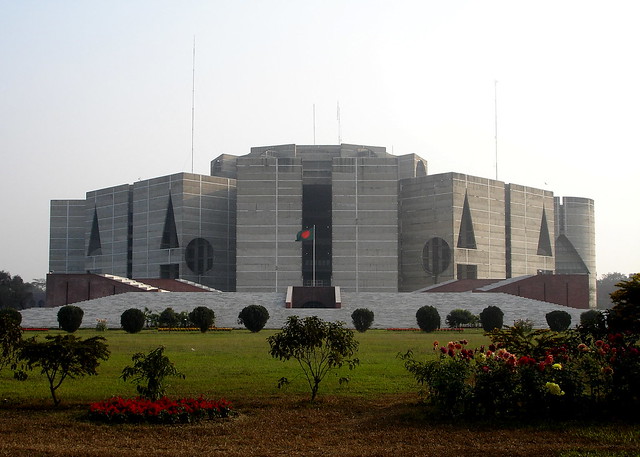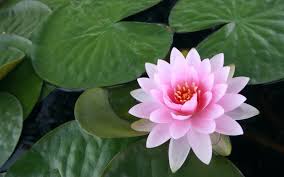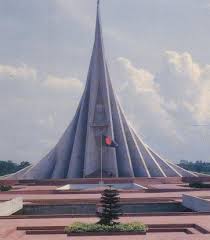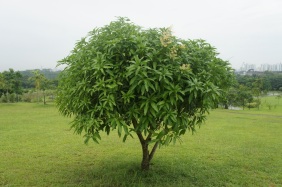
consist of symbols to represent Bangladeshi traditions and ideals that reflect the different aspects of the cultural life and history. Bangladesh has several official national symbols including a historic document, a flag, an emblem, an anthem, memorial towers as well as several national heroes. There are also several other symbols including the national animal, bird, flower and tree.
Flag of Bangladesh

The national Flag of Bangladesh (বাংলাদেশের জাতীয় পতাকা), known as Red-Green, was adopted officially on 17 January 1972. It consists of a red disc on top of a green field, offset slightly toward the hoist so that it appears centred when the flag is flying. The red disc represents the sun rising over Bengal, and also the blood of those who died for the independence of Bangladesh. The green field stands for the lushness of the land of Bangladesh.[1] The flag is based on a similar flag used during the Bangladesh Liberation War of 1971, which had a yellow map of the country inside the red disc. In 1972 this map was deleted from the flag. One reason given was the difficulty for rendering the map correctly on both sides of the flag. The civil ensign and naval ensign place the national flag in the canton of a red or white field, respectively.
National Emblem of Bangladesh

The national emblem of Bangladesh (বাংলাদেশের জাতীয় প্রতীক) was adopted shortly after independence in 1971. Located on the emblem is a water lily, that is bordered on two sides by rice sheaves. Above the water lilly are four stars and a three connected jute leaves. The water lily is the country’s national flower, and is representative of the many rivers that run through Bangladesh. Rice represents its presence as the staple food of Bangladesh, and for the agriculture of that nation. The four stars represent the four founding principles in the current constitution of Bangladesh of 1972: nationalism, secularism, socialism, and democracy…
Bangladesh teems with icons and symbols, not the least of which is the ubiquitous Royal Bengal Tiger. This majestic beast finds its home in Bangladesh, in the still pristine mangrove forests of the Sundarbans.

The Doel or the magpie robin is the national bird of Bangladesh.

The Jackfruit [Kathal] is our national fruit. The fruit has a pungent yet distinctive flavor not unlike the Durian of South East Asia. The fruit can grow to huge sizes hundreds of pounds in weight.

The National Parliament (shawngshod bhawbon) is an architectural wonder. Designed by the famous American architect Louis Kahn, this is the seat of the government

The Water Lily (shapla) is the national flower of Bangladesh. The water lily is representative of the many rivers that run through Bangladesh.

Shaheed Minar (Martyrs Memorial): We truly value our independence and the sacrifices made to achieve our freedom. Starting as a language movement, nascent nationalism culminated in the birth of Bangladesh after a 9 month long War of Independence.

The National Monument reminds us of those who gave their lives so the we can be free. Here in this sombre memorial we remember the first sacrifices made to preserve our freedom and independence.

The Martyred Intellectuals Memorial (বুদ্ধিজীবি স্মৃতি সৌধ) is a memorial built in memory of the martyred intellectuals of Bangladesh Liberation War. The memorial, located at Rayerbazar, Mohammadpur Thana in Dhaka,[24] was designed by architect Farid U Ahmed and Jami Al Shafi.[25][26][27]
During the entire duration of Bangladesh Liberation War of 1971, a large number of teachers, doctors, engineers, poets and writers were systematically massacred by Pakistan Army and their local collaborators, most notably the alleged Islamistmilitia groups Al-Badr and Al-Shams. The largest number of assassinations took place on December 14, 1971, only two days before the surrender of Pakistan army to the joint force of Indian army and Mukti bahini. The initial proposal for a memorial at Rayer Bazar was brought forward by Projonmo 71 (organisation of the children of the martyrs of liberation war), who also laid a temporary foundation stone in 1991.

The Mango is the national tree of Bangladesh. The mango is native to South Asia, from where it has been distributed worldwide to become one of the most cultivated fruits in thetropics. Its fruit and leaves are ritually used as floral decorations at weddings, public celebrations and religious ceremonies

The Ilish (Bengali: ইলিশ) or Hilsha, also spelled Elish (Tenualosa ilisha), is national fish of Bangladesh. As it is anadromous in nature (an uncommon phenomenon in tropical waters), the Ilish lives in the sea for most of its life, but migrates up to 1,200 km inland through rivers in the Indian sub-continent for spawning. Distances of 50–100 km are usually normal in the Bangladeshi rivers. The Ilish is a popular fish to eat among the people of South Asia.

Other national and official symbols
প্রিয় পাঠক, আপনাদের চোখে যদি কোন রকম ভুল-ত্রুটি চোখে পড়ে তাহলে কমেন্ট করে জানিয়ে দিলে ভাল হবে। আপনারাও কমেন্ট বক্সে কমেন্ট করে রসায়ন নিয়ে আপনার জানা তথ্যগুলো আমাদের সবাইকে জানাতে পারেন।
















